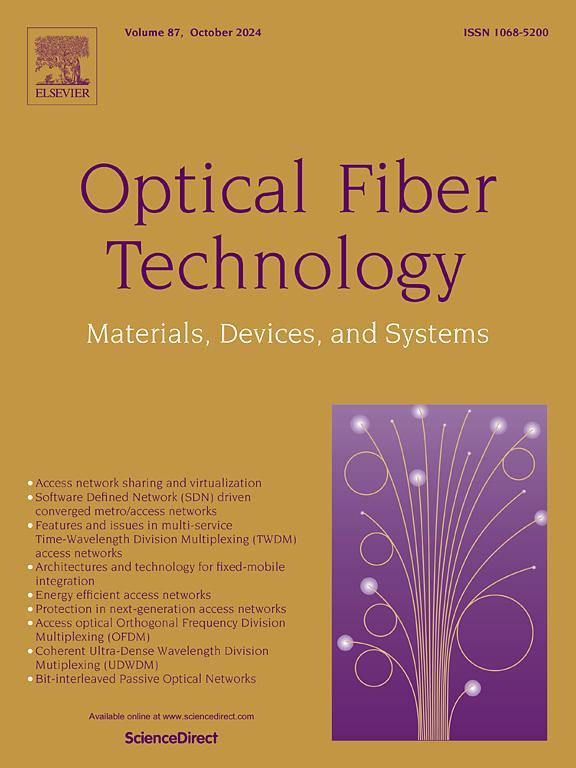Reinforcement learning-driven multicast routing in Elastic Optical Networks: A multi-objective cost optimization framework
IF 2.7
3区 计算机科学
Q2 ENGINEERING, ELECTRICAL & ELECTRONIC
引用次数: 0
Abstract
Data traffic demand is increasing every year, and networks must respond to these increasing demands. On the other hand, Wavelength Division Multiplexing (WDM) networks, due to their static allocation, waste resources and are unable to meet the necessary requirements. To solve this problem, Elastic Optical Networks (EONs) with dynamic spectrum allocation have been developed, and it has been shown that EONs can enhance resource utilization relative to WDM-based networks. The main challenge in EONs is efficiently allocating resources to optimize network capacity utilization. On the one hand, Dynamic spectrum assignment and diverse available schemes for demands lead to higher spectrum utilization. Multicasting, also known as multi-destination data transfer, is one of the most cost-effective and efficient techniques for providing flow in computer networks, a technology attracting considerable attention due to the widespread adoption of internet-based services. This paper introduces a novel RL-driven framework for multi-objective cost optimization in dynamic multicast routing. We propose two algorithms: MIN (Multicasting through Intermediate Nodes) and MIN2P (via 2 Paths), which integrate hop count, physical distance, and frequency slot congestion into a unified cost function. MIN leverages intermediate nodes (destination and non-destination) via SPT algorithm for logical tree construction, while MIN2P enhances load balancing by splitting traffic across two paths with first-fit and last-fit spectrum allocation. For the first time, a Q-learning-based reinforcement learning (RL) agent adaptively tunes the cost function weights in real-time, responding to network conditions to minimize blocking probability. Simulations on NSFNET and JPN12 topologies, with varying traffic loads (100–800 Gbps), demonstrate that hop count is the most influential metric, reducing blocking rates by up to 30% compared to benchmarks like OL-M-SFMOR and MT3A. MIN excels in low-congestion scenarios, while MIN2P outperforms in high-load, large topologies due to effective load distribution. This framework provides actionable insights for designing adaptive, efficient EONs, advancing multicast capabilities in next-generation optical networks.
弹性光网络中强化学习驱动的组播路由:一个多目标成本优化框架
数据流量需求每年都在增长,网络必须满足这些不断增长的需求。另一方面,波分复用(Wavelength Division Multiplexing, WDM)网络由于其静态分配而造成资源浪费,无法满足必要的需求。为了解决这一问题,人们开发了具有动态频谱分配的弹性光网络(Elastic Optical network, EONs),研究表明,相对于基于wdm的网络,弹性光网络可以提高资源利用率。eon面临的主要挑战是如何有效地分配资源以优化网络容量利用率。一方面,动态频谱分配和多样化的可用方案满足需求,提高了频谱利用率。多播,也被称为多目的地数据传输,是计算机网络中最具成本效益和效率的数据传输技术之一,由于基于internet的服务的广泛采用,这一技术引起了相当大的关注。提出了一种新的rl驱动的动态组播路由多目标成本优化框架。我们提出了两种算法:MIN(通过中间节点的多播)和MIN2P(通过2条路径),它们将跳数、物理距离和频率槽拥塞集成到一个统一的成本函数中。MIN通过SPT算法利用中间节点(目的节点和非目的节点)进行逻辑树构建,而MIN2P通过在两条路径上划分流量来增强负载均衡,并进行首次拟合和最后拟合频谱分配。基于q学习的强化学习(RL)智能体首次自适应实时调整成本函数权重,响应网络条件以最小化阻塞概率。在不同流量负载(100-800 Gbps)的NSFNET和JPN12拓扑上进行的仿真表明,跳数是最具影响力的指标,与OL-M-SFMOR和MT3A等基准相比,它可将阻塞率降低多达30%。MIN在低拥塞场景中表现出色,而MIN2P由于有效的负载分配而在高负载、大型拓扑中表现出色。该框架为设计自适应、高效的eon、推进下一代光网络的多播能力提供了可行的见解。
本文章由计算机程序翻译,如有差异,请以英文原文为准。
求助全文
约1分钟内获得全文
求助全文
来源期刊

Optical Fiber Technology
工程技术-电信学
CiteScore
4.80
自引率
11.10%
发文量
327
审稿时长
63 days
期刊介绍:
Innovations in optical fiber technology are revolutionizing world communications. Newly developed fiber amplifiers allow for direct transmission of high-speed signals over transcontinental distances without the need for electronic regeneration. Optical fibers find new applications in data processing. The impact of fiber materials, devices, and systems on communications in the coming decades will create an abundance of primary literature and the need for up-to-date reviews.
Optical Fiber Technology: Materials, Devices, and Systems is a new cutting-edge journal designed to fill a need in this rapidly evolving field for speedy publication of regular length papers. Both theoretical and experimental papers on fiber materials, devices, and system performance evaluation and measurements are eligible, with emphasis on practical applications.
 求助内容:
求助内容: 应助结果提醒方式:
应助结果提醒方式:


